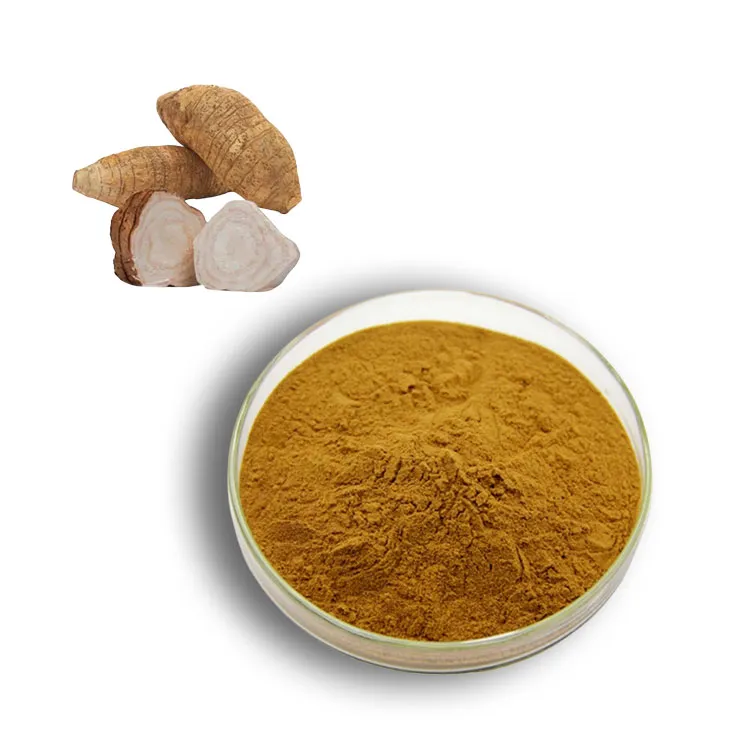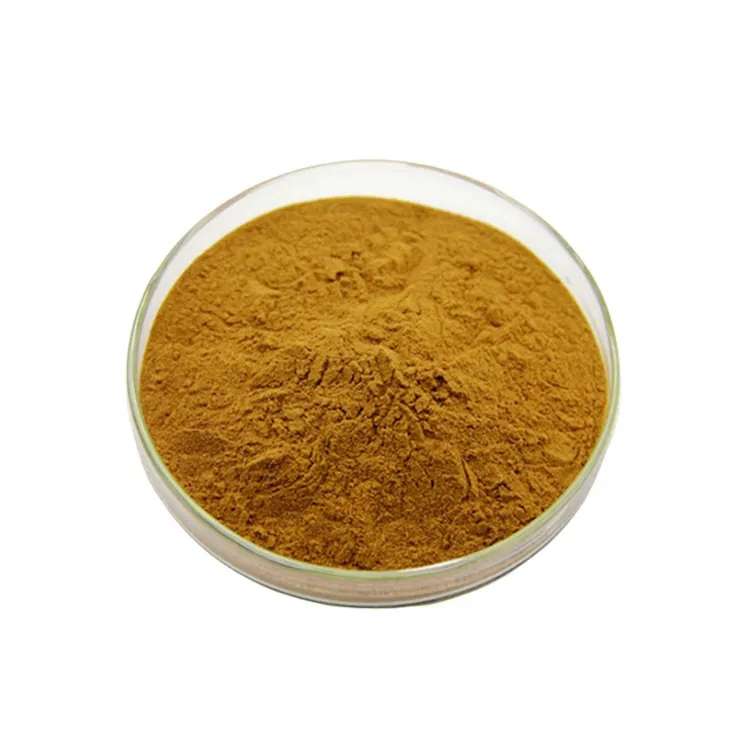- 0086-571-85302990
- sales@greenskybio.com
Organic Pueraria Lobata Extract Powder Factory.
2024-11-28

Introduction to the Factory
The organic Pueraria Lobata Extract powder factory is truly a place where nature meets technology. Organic Pueraria lobata, a plant renowned for its rich medicinal and nutritional value, undergoes a remarkable transformation here into a useful powder form. This factory plays a crucial role in the utilization and commercialization of this valuable plant resource.

The Production Process
1. Sourcing of Organic Pueraria Lobata
The production process in the factory is a complex yet well - organized chain. It all begins with the sourcing of the organic Pueraria lobata. The plant is sourced from reliable organic farms. These farms adhere to strict organic farming standards, ensuring that the Pueraria lobata is free from pesticides, chemical fertilizers, and other contaminants. This is of utmost importance as the quality of the final extract powder is highly dependent on the purity of the raw material.
2. Extraction Methods
Once the raw material is obtained, the next step is extraction. The factory employs state - of - - art extraction methods to isolate the valuable components from the plant material. There are primarily two main extraction methods used:
- Solvent Extraction: In solvent extraction, a suitable solvent is used to dissolve the desired components from the Pueraria lobata. The choice of solvent is crucial as it should be able to selectively extract the active ingredients while leaving behind unwanted substances. Commonly used solvents include ethanol, which is relatively safe and effective in extracting a wide range of bioactive compounds. However, the process requires careful control of parameters such as temperature, time, and solvent - to - plant ratio to ensure optimal extraction efficiency and product quality.
- Supercritical Fluid Extraction: This is a more advanced and environmentally friendly extraction method. Supercritical fluids, typically carbon dioxide in a supercritical state, are used. Supercritical carbon dioxide has properties that are intermediate between a gas and a liquid, allowing it to penetrate the plant material easily and selectively extract the valuable components. One of the major advantages of this method is that it can produce a highly pure extract with minimal residue, as carbon dioxide can be easily removed from the final product by simply reducing the pressure.
The choice between these two methods often depends on the desired quality and purity of the final product. For example, if a very high - purity extract is required for use in high - end cosmetics or pharmaceuticals, supercritical fluid extraction may be the preferred method. On the other hand, solvent extraction may be more suitable for large - scale production of extract powder for general nutraceutical applications due to its relatively lower cost and simpler equipment requirements.
3. Purification and Concentration
After the extraction step, the resulting extract usually contains a mixture of various components along with the solvent. Therefore, purification and concentration steps are necessary. These steps involve techniques such as filtration, distillation, and chromatography. Filtration is used to remove solid particles and impurities from the extract. Distillation can be used to remove the solvent, leaving behind a more concentrated extract. Chromatography, on the other hand, can be used to further separate and purify the individual components of the extract based on their chemical properties, such as polarity or molecular size.
4. Drying and Powder Formation
Once the extract has been purified and concentrated, it is then dried to form a powder. There are different drying methods available, such as spray drying and freeze - drying. Spray drying is a common method in which the liquid extract is sprayed into a hot air stream, causing the water or solvent to evaporate quickly, leaving behind fine powder particles. Freeze - drying, on the other hand, involves freezing the extract first and then removing the water or solvent by sublimation under reduced pressure. This method is often used for heat - sensitive extracts as it can preserve the bioactivity of the components better. The resulting powder is then carefully collected, packaged, and ready for further processing or distribution.

Environmental Sustainability in the Factory
The factory also focuses on environmental sustainability. Since it deals with organic materials, it adheres to strict environmental protection regulations.
1. Waste Management during Extraction
During the extraction process, proper waste management is crucial. The waste generated from the extraction, such as used solvents and plant residues, needs to be disposed of properly. For example, used solvents are often recycled or treated to meet environmental discharge standards. Plant residues can be composted or used for other purposes such as biofuel production, reducing waste and maximizing resource utilization.
2. Use of Energy - Efficient Equipment
The factory also invests in energy - efficient equipment. This not only helps to reduce the operational costs but also has a positive impact on the environment. For example, modern extraction equipment is designed to operate with high efficiency, reducing the amount of energy required per unit of product. Additionally, energy - saving measures such as heat recovery systems can be implemented in the drying processes, where the heat generated during drying can be reused for other parts of the production process, further reducing energy consumption.

Product Development in the Factory
The factory constantly researches new applications of the Pueraria Lobata Extract powder. It recognizes the vast potential of this natural extract and is committed to exploring its diverse uses.
1. Collaboration with Research Institutions
The factory actively collaborates with research institutions. These collaborations are essential for staying at the forefront of product development. By working together with scientific experts, the factory can access the latest research findings and technologies. For example, in the cosmetics industry, research institutions can conduct in - vitro and in - vivo studies to explore the anti - - aging properties of Pueraria Lobata Extract powder. In the nutraceutical field, they can study the potential health - promoting effects on various physiological functions such as blood sugar regulation, cardiovascular health, and immune system enhancement.
2. Applications in the Cosmetics Industry
In the cosmetics industry, the Pueraria lobata extract powder shows great promise. It has been found to have antioxidant and anti - - aging properties. Antioxidants are important for protecting the skin from free radical damage, which is one of the main causes of skin aging. The extract powder can be incorporated into various cosmetic products such as creams, lotions, and serums. For example:
- Skin Creams: In skin creams, the Pueraria lobata extract powder can help to improve skin elasticity, reduce wrinkles, and moisturize the skin. It can be combined with other active ingredients such as hyaluronic acid and vitamins to enhance its effectiveness.
- Anti - - Aging Serums: Anti - - aging serums formulated with Pueraria lobata extract powder can target specific signs of aging such as fine lines and age spots. The bioactive compounds in the extract can penetrate deep into the skin layers, promoting collagen synthesis and cell renewal.
3. Applications in the Nutraceutical Field
In the nutraceutical field, the Pueraria lobata extract powder is also being explored for its various health - promoting properties. Some of the potential applications include:
- Blood Sugar Regulation: There is evidence to suggest that certain components in the Pueraria lobata extract may help in regulating blood sugar levels. This makes it a potential ingredient in dietary supplements for people with diabetes or those at risk of developing diabetes.
- Cardiovascular Health: The extract may also have beneficial effects on cardiovascular health. It could potentially help in reducing cholesterol levels, improving blood circulation, and preventing heart diseases. Dietary supplements containing Pueraria lobata extract powder could be developed for promoting heart health.
- Immune System Enhancement: Another area of interest is the potential of the extract to enhance the immune system. By incorporating it into nutraceutical products, it may help to boost the body's natural defense mechanisms against diseases.
Conclusion
Overall, the organic Pueraria lobata extract powder factory is at the forefront of the industry, driving innovation and ensuring the high - quality production of this valuable natural extract. Through its strict quality control in the production process, commitment to environmental sustainability, and continuous product development efforts, the factory is well - positioned to meet the growing demand for Pueraria lobata extract powder in various industries such as cosmetics and nutraceuticals. As research on the plant's properties and applications continues to expand, the factory will likely play an even more important role in the future development and utilization of this natural resource.
FAQ:
What are the main extraction methods used in the Organic Pueraria Lobata Extract Powder Factory?
The main extraction methods used in the factory are solvent extraction and supercritical fluid extraction. These methods are chosen depending on the desired quality and purity of the final product. Solvent extraction uses a suitable solvent to isolate the valuable components from the Pueraria lobata plant material. Supercritical fluid extraction, on the other hand, is a more advanced method that can often result in a higher - quality extract with better purity.
How does the factory ensure the organic nature of the Pueraria lobata?
The factory ensures the organic nature of the Pueraria lobata by sourcing it from reliable organic farms. These farms follow strict organic farming standards, which means no use of synthetic pesticides, fertilizers, or genetically modified organisms. The factory also likely has its own quality control measures in place to verify the organic status of the incoming plant material.
What role does environmental sustainability play in the factory?
Environmental sustainability is very important in the factory. Since it deals with organic materials, it adheres to strict environmental protection regulations. This includes proper waste management during the extraction process. For example, any waste solvents or by - products are disposed of in an environmentally friendly way. The factory also uses energy - efficient equipment to reduce its carbon footprint and overall impact on the environment.
How does the factory promote product development?
The factory promotes product development by constantly researching new applications of the Pueraria lobata extract powder. It collaborates with research institutions. For example, in the cosmetics industry, they explore its potential in anti - aging products. In the nutraceutical field, they work on developing new health - promoting formulas. This collaborative approach helps to drive innovation and find new uses for the extract powder.
What quality control measures are in place in the factory?
The factory likely has several quality control measures in place. This includes verifying the organic status of the Pueraria lobata source material. During the extraction process, they may monitor parameters such as temperature, pressure, and extraction time to ensure consistent quality. After extraction, the powder is likely tested for purity, potency, and absence of contaminants. Final products may also be subject to batch - to - batch consistency testing.
Related literature
- Organic Farming and Pueraria Lobata: A Comprehensive Study"
- "The Extraction Technologies in Pueraria Lobata Processing"
- "Environmental Impact of Extract Powder Production from Organic Plants"
- "Product Development in the Field of Pueraria Lobata Extracts"
- ▶ Hesperidin
- ▶ Citrus Bioflavonoids
- ▶ Plant Extract
- ▶ lycopene
- ▶ Diosmin
- ▶ Grape seed extract
- ▶ Sea buckthorn Juice Powder
- ▶ Fruit Juice Powder
- ▶ Hops Extract
- ▶ Artichoke Extract
- ▶ Mushroom extract
- ▶ Astaxanthin
- ▶ Green Tea Extract
- ▶ Curcumin
- ▶ Horse Chestnut Extract
- ▶ Other Product
- ▶ Boswellia Serrata Extract
- ▶ Resveratrol
- ▶ Marigold Extract
- ▶ Grape Leaf Extract
- ▶ New Product
- ▶ Aminolevulinic acid
- ▶ Cranberry Extract
- ▶ Red Yeast Rice
- ▶ Red Wine Extract
-
Kidney Bean Extract
2024-11-28
-
Pueraria Lobata Extract
2024-11-28
-
Ginger Extract
2024-11-28
-
Dan Shen Root Extract/Salvia Root Extract
2024-11-28
-
Artichoke Leaf Extract
2024-11-28
-
Apricot Powder
2024-11-28
-
Quercetin
2024-11-28
-
Cassia Seed Extract
2024-11-28
-
Cranberry Extract
2024-11-28
-
Coix Seed Extract
2024-11-28




















